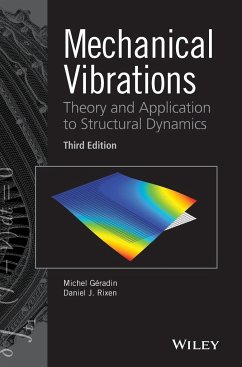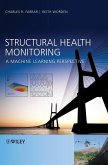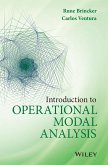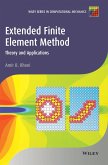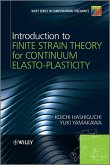Schade – dieser Artikel ist leider ausverkauft. Sobald wir wissen, ob und wann der Artikel wieder verfügbar ist, informieren wir Sie an dieser Stelle.
- Gebundenes Buch
- Merkliste
- Auf die Merkliste
- Bewerten Bewerten
- Teilen
- Produkt teilen
- Produkterinnerung
- Produkterinnerung
Mechanical Vibrations: Theory and Application to StructuralDynamics, Third Edition is a comprehensively updated newedition of the popular textbook. It presents the theory ofvibrations in the context of structural analysis and coversapplications in mechanical and aerospace engineering.
Key features include:
A systematic approach to dynamic reduction and substructuring,based on duality between mechanical and admittance concepts An introduction to experimental modal analysis andidentification methods An improved, more physical presentation of wave propagationphenomena A comprehensive…mehr
Andere Kunden interessierten sich auch für
![Structural Health Monitoring Structural Health Monitoring]() Charles R. FarrarStructural Health Monitoring177,99 €
Charles R. FarrarStructural Health Monitoring177,99 €![Vibrations and Waves in Continuous Mechanical Systems Vibrations and Waves in Continuous Mechanical Systems]() Peter HagedornVibrations and Waves in Continuous Mechanical Systems130,99 €
Peter HagedornVibrations and Waves in Continuous Mechanical Systems130,99 €![Introduction to Operational Modal Analysis Introduction to Operational Modal Analysis]() Rune BrinckerIntroduction to Operational Modal Analysis153,99 €
Rune BrinckerIntroduction to Operational Modal Analysis153,99 €![Extended Finite Element Method Extended Finite Element Method]() Amir R. KhoeiExtended Finite Element Method165,99 €
Amir R. KhoeiExtended Finite Element Method165,99 €![Introduction to Finite Strain Theory for Continuum Elasto-Plasticity Introduction to Finite Strain Theory for Continuum Elasto-Plasticity]() Koichi HashiguchiIntroduction to Finite Strain Theory for Continuum Elasto-Plasticity174,99 €
Koichi HashiguchiIntroduction to Finite Strain Theory for Continuum Elasto-Plasticity174,99 €![Finite Element Analysis of Structures Through Unified Formulation Finite Element Analysis of Structures Through Unified Formulation]() Erasmo CarreraFinite Element Analysis of Structures Through Unified Formulation154,99 €
Erasmo CarreraFinite Element Analysis of Structures Through Unified Formulation154,99 €![Encyclopedia of Aerospace Engineering, 9 Volume Set Encyclopedia of Aerospace Engineering, 9 Volume Set]() Richard BlockleyEncyclopedia of Aerospace Engineering, 9 Volume Set4.685,99 €
Richard BlockleyEncyclopedia of Aerospace Engineering, 9 Volume Set4.685,99 €-
-
-
Mechanical Vibrations: Theory and Application to StructuralDynamics, Third Edition is a comprehensively updated newedition of the popular textbook. It presents the theory ofvibrations in the context of structural analysis and coversapplications in mechanical and aerospace engineering.
Key features include:
A systematic approach to dynamic reduction and substructuring,based on duality between mechanical and admittance concepts
An introduction to experimental modal analysis andidentification methods
An improved, more physical presentation of wave propagationphenomena
A comprehensive presentation of current practice for solvinglarge eigenproblems, focusing on the efficient linear solution oflarge, sparse and possibly singular systems
A deeply revised description of time integration schemes,providing framework for the rigorous accuracy/stability analysis ofnow widely used algorithms such as HHT and Generalized-
Solved exercises and end of chapter homework problems
A companion website hosting supplementary material
Key features include:
A systematic approach to dynamic reduction and substructuring,based on duality between mechanical and admittance concepts
An introduction to experimental modal analysis andidentification methods
An improved, more physical presentation of wave propagationphenomena
A comprehensive presentation of current practice for solvinglarge eigenproblems, focusing on the efficient linear solution oflarge, sparse and possibly singular systems
A deeply revised description of time integration schemes,providing framework for the rigorous accuracy/stability analysis ofnow widely used algorithms such as HHT and Generalized-
Solved exercises and end of chapter homework problems
A companion website hosting supplementary material
Produktdetails
- Produktdetails
- Verlag: Wiley & Sons
- Artikelnr. des Verlages: 1W118900200
- 3. Aufl.
- Seitenzahl: 616
- Erscheinungstermin: 1. Januar 1900
- Englisch
- Abmessung: 250mm x 175mm x 37mm
- Gewicht: 1229g
- ISBN-13: 9781118900208
- ISBN-10: 1118900200
- Artikelnr.: 41377104
- Verlag: Wiley & Sons
- Artikelnr. des Verlages: 1W118900200
- 3. Aufl.
- Seitenzahl: 616
- Erscheinungstermin: 1. Januar 1900
- Englisch
- Abmessung: 250mm x 175mm x 37mm
- Gewicht: 1229g
- ISBN-13: 9781118900208
- ISBN-10: 1118900200
- Artikelnr.: 41377104
Michel Géradin holds an Engineering Degree in Physics and a PhD from ULg (University of Liège, Belgium). Successively he has been a research fellow from the Belgian FNRS (1968-1979), Professor of Structural Dynamics at ULg (1979-2010) and Unit Head of the European Laboratory for Structural Assessment (ELSA) of the JRC (European Commission Ispra, Italy) (1997-2010). He has also been a Visiting Scholar at Stanford University (1973-1974) and Visiting Professor at the University of Colorado (1986-1987). He developed research activity in finite element methodology, computational methods in structural dynamics and multibody dynamics. He has been a co-author of the finite element software SAMCEF and co-founding member of Samtech SA in 1986. He is Doctor Honoris Causa at the Technical University of Lisbon (1996) and École Centrale de Nantes (2007), and an Associate Member of the Royal Academy of Sciences of Belgium (2000). He is the co-author of Flexible Multibody Dynamics. A Finite Element Approach (Wiley, 2000). Daniel Rixen holds an MSc in Aerospace Vehicle Design from the College of Aeronautics in Cranfield (UK) and received his Mechanical Engineering and Doctorate degree from the University of Liège (Belgium) supported by the Belgium National Research Fund. After having spent two years as researcher at the Center for Aerospace Structures (University of Colorado, Boulder) between 2000 and 2012 he chaired the Engineering Dynamic group at the Delft University of Technology (The Netherlands). Since 2012 he heads the Institute for Applied Mechanics at the Technische Universität München (Germany). Next to teaching, his passion comprises research on numerical and simulation methods as well as experimental techniques, involving structural and multiphysical applications in e.g. aerospace, automotive, mechatronics, biodynamics and wind energy. A recurring aspect in his investigation is the interaction between system components such as in domain decomposition for parallel computing or component synthesis in dynamic model reduction and in experimental substructuring.
Foreword xiii Preface xv Introduction 1 Suggested Bibliography 7 1
Analytical Dynamics of Discrete Systems 13 1.1 Principle of Virtual Work
for a Particle 14 1.2 Extension to a System of Particles 17 1.3 Hamilton's
Principle for Conservative Systems and Lagrange Equations 23 1.4 Lagrange
Equations in the General Case 36 1.5 Lagrange Equations for Impulsive
Loading 39 1.6 Dynamics of Constrained Systems 44 1.7 Exercises 46
References 54 2 Undamped Vibrations of n-Degree-of-Freedom Systems 57 2.1
Linear Vibrations about an Equilibrium Configuration 59 2.2 Normal Modes of
Vibration 67 2.3 Orthogonality of Vibration Eigenmodes 70 2.4 Vector and
Matrix Spectral Expansions Using Eigenmodes 76 2.5 Free Vibrations Induced
by Nonzero Initial Conditions 77 2.6 Response to Applied Forces: Forced
Harmonic Response 83 2.7 Response to Applied Forces: Response in the Time
Domain 91 2.8 Modal Approximations of Dynamic Responses 95 2.9 Response to
Support Motion 101 2.10 Variational Methods for Eigenvalue Characterization
111 2.11 Conservative Rotating Systems 119 2.12 Exercises 130 References
148 3 Damped Vibrations of n-Degree-of-Freedom Systems 149 3.1 Damped
Oscillations in Terms of Normal Eigensolutions of the Undamped System 151
3.2 Forced Harmonic Response 160 3.3 State-Space Formulation of Damped
Systems 174 3.4 Experimental Methods of Modal Identification 180 3.5
Exercises 199 3.6 Proposed Exercises 207 References 208 4 Continuous
Systems 211 4.1 Kinematic Description of the Dynamic Behaviour of
Continuous Systems: Hamilton's Principle 213 4.2 Free Vibrations of Linear
Continuous Systems and Response to External Excitation 231 4.3
One-Dimensional Continuous Systems 243 4.4 Bending Vibrations of Thin
Plates 290 4.5 Wave Propagation in a Homogeneous Elastic Medium 315 4.6
Solved Exercises 327 4.7 Proposed Exercises 328 References 333 5
Approximation of Continuous Systems by Displacement Methods 335 5.1 The
Rayleigh-Ritz Method 339 5.2 Applications of the Rayleigh-Ritz Method to
Continuous Systems 346 5.3 The Finite Element Method 362 5.4 Exercises 399
References 412 6 Solution Methods for the Eigenvalue Problem 415 6.1
General considerations 419 6.2 Dynamical and Symmetric Iteration Matrices
425 6.3 Computing the Determinant: Sturm Sequences 426 6.4 Matrix
Transformation Methods 430 6.5 Iteration on Eigenvectors: The Power
Algorithm 436 6.6 Solution Methods for a Linear Set of Equations 444 6.7
Practical Aspects of Inverse Iteration Methods 460 6.8 Subspace
Construction Methods 464 6.9 Dynamic Reduction and Substructuring 479 6.10
Error Bounds to Eigenvalues 488 6.11 Sensitivity of Eigensolutions, Model
Updating and Dynamic Optimization 498 6.12 Exercises 504 References 508 7
Direct Time-Integration Methods 511 7.1 Linear Multistep Integration
Methods 513 7.2 One-Step Formulas for Second-Order Systems: Newmark's
Family 522 7.3 Equilibrium Averaging Methods 539 7.4 Energy Conservation
550 7.5 Explicit Time Integration Using the Central Difference Algorithm
556 7.6 The Nonlinear Case 564 7.7 Exercises 573 References 575 Index 577
Analytical Dynamics of Discrete Systems 13 1.1 Principle of Virtual Work
for a Particle 14 1.2 Extension to a System of Particles 17 1.3 Hamilton's
Principle for Conservative Systems and Lagrange Equations 23 1.4 Lagrange
Equations in the General Case 36 1.5 Lagrange Equations for Impulsive
Loading 39 1.6 Dynamics of Constrained Systems 44 1.7 Exercises 46
References 54 2 Undamped Vibrations of n-Degree-of-Freedom Systems 57 2.1
Linear Vibrations about an Equilibrium Configuration 59 2.2 Normal Modes of
Vibration 67 2.3 Orthogonality of Vibration Eigenmodes 70 2.4 Vector and
Matrix Spectral Expansions Using Eigenmodes 76 2.5 Free Vibrations Induced
by Nonzero Initial Conditions 77 2.6 Response to Applied Forces: Forced
Harmonic Response 83 2.7 Response to Applied Forces: Response in the Time
Domain 91 2.8 Modal Approximations of Dynamic Responses 95 2.9 Response to
Support Motion 101 2.10 Variational Methods for Eigenvalue Characterization
111 2.11 Conservative Rotating Systems 119 2.12 Exercises 130 References
148 3 Damped Vibrations of n-Degree-of-Freedom Systems 149 3.1 Damped
Oscillations in Terms of Normal Eigensolutions of the Undamped System 151
3.2 Forced Harmonic Response 160 3.3 State-Space Formulation of Damped
Systems 174 3.4 Experimental Methods of Modal Identification 180 3.5
Exercises 199 3.6 Proposed Exercises 207 References 208 4 Continuous
Systems 211 4.1 Kinematic Description of the Dynamic Behaviour of
Continuous Systems: Hamilton's Principle 213 4.2 Free Vibrations of Linear
Continuous Systems and Response to External Excitation 231 4.3
One-Dimensional Continuous Systems 243 4.4 Bending Vibrations of Thin
Plates 290 4.5 Wave Propagation in a Homogeneous Elastic Medium 315 4.6
Solved Exercises 327 4.7 Proposed Exercises 328 References 333 5
Approximation of Continuous Systems by Displacement Methods 335 5.1 The
Rayleigh-Ritz Method 339 5.2 Applications of the Rayleigh-Ritz Method to
Continuous Systems 346 5.3 The Finite Element Method 362 5.4 Exercises 399
References 412 6 Solution Methods for the Eigenvalue Problem 415 6.1
General considerations 419 6.2 Dynamical and Symmetric Iteration Matrices
425 6.3 Computing the Determinant: Sturm Sequences 426 6.4 Matrix
Transformation Methods 430 6.5 Iteration on Eigenvectors: The Power
Algorithm 436 6.6 Solution Methods for a Linear Set of Equations 444 6.7
Practical Aspects of Inverse Iteration Methods 460 6.8 Subspace
Construction Methods 464 6.9 Dynamic Reduction and Substructuring 479 6.10
Error Bounds to Eigenvalues 488 6.11 Sensitivity of Eigensolutions, Model
Updating and Dynamic Optimization 498 6.12 Exercises 504 References 508 7
Direct Time-Integration Methods 511 7.1 Linear Multistep Integration
Methods 513 7.2 One-Step Formulas for Second-Order Systems: Newmark's
Family 522 7.3 Equilibrium Averaging Methods 539 7.4 Energy Conservation
550 7.5 Explicit Time Integration Using the Central Difference Algorithm
556 7.6 The Nonlinear Case 564 7.7 Exercises 573 References 575 Index 577
Foreword xiii Preface xv Introduction 1 Suggested Bibliography 7 1
Analytical Dynamics of Discrete Systems 13 1.1 Principle of Virtual Work
for a Particle 14 1.2 Extension to a System of Particles 17 1.3 Hamilton's
Principle for Conservative Systems and Lagrange Equations 23 1.4 Lagrange
Equations in the General Case 36 1.5 Lagrange Equations for Impulsive
Loading 39 1.6 Dynamics of Constrained Systems 44 1.7 Exercises 46
References 54 2 Undamped Vibrations of n-Degree-of-Freedom Systems 57 2.1
Linear Vibrations about an Equilibrium Configuration 59 2.2 Normal Modes of
Vibration 67 2.3 Orthogonality of Vibration Eigenmodes 70 2.4 Vector and
Matrix Spectral Expansions Using Eigenmodes 76 2.5 Free Vibrations Induced
by Nonzero Initial Conditions 77 2.6 Response to Applied Forces: Forced
Harmonic Response 83 2.7 Response to Applied Forces: Response in the Time
Domain 91 2.8 Modal Approximations of Dynamic Responses 95 2.9 Response to
Support Motion 101 2.10 Variational Methods for Eigenvalue Characterization
111 2.11 Conservative Rotating Systems 119 2.12 Exercises 130 References
148 3 Damped Vibrations of n-Degree-of-Freedom Systems 149 3.1 Damped
Oscillations in Terms of Normal Eigensolutions of the Undamped System 151
3.2 Forced Harmonic Response 160 3.3 State-Space Formulation of Damped
Systems 174 3.4 Experimental Methods of Modal Identification 180 3.5
Exercises 199 3.6 Proposed Exercises 207 References 208 4 Continuous
Systems 211 4.1 Kinematic Description of the Dynamic Behaviour of
Continuous Systems: Hamilton's Principle 213 4.2 Free Vibrations of Linear
Continuous Systems and Response to External Excitation 231 4.3
One-Dimensional Continuous Systems 243 4.4 Bending Vibrations of Thin
Plates 290 4.5 Wave Propagation in a Homogeneous Elastic Medium 315 4.6
Solved Exercises 327 4.7 Proposed Exercises 328 References 333 5
Approximation of Continuous Systems by Displacement Methods 335 5.1 The
Rayleigh-Ritz Method 339 5.2 Applications of the Rayleigh-Ritz Method to
Continuous Systems 346 5.3 The Finite Element Method 362 5.4 Exercises 399
References 412 6 Solution Methods for the Eigenvalue Problem 415 6.1
General considerations 419 6.2 Dynamical and Symmetric Iteration Matrices
425 6.3 Computing the Determinant: Sturm Sequences 426 6.4 Matrix
Transformation Methods 430 6.5 Iteration on Eigenvectors: The Power
Algorithm 436 6.6 Solution Methods for a Linear Set of Equations 444 6.7
Practical Aspects of Inverse Iteration Methods 460 6.8 Subspace
Construction Methods 464 6.9 Dynamic Reduction and Substructuring 479 6.10
Error Bounds to Eigenvalues 488 6.11 Sensitivity of Eigensolutions, Model
Updating and Dynamic Optimization 498 6.12 Exercises 504 References 508 7
Direct Time-Integration Methods 511 7.1 Linear Multistep Integration
Methods 513 7.2 One-Step Formulas for Second-Order Systems: Newmark's
Family 522 7.3 Equilibrium Averaging Methods 539 7.4 Energy Conservation
550 7.5 Explicit Time Integration Using the Central Difference Algorithm
556 7.6 The Nonlinear Case 564 7.7 Exercises 573 References 575 Index 577
Analytical Dynamics of Discrete Systems 13 1.1 Principle of Virtual Work
for a Particle 14 1.2 Extension to a System of Particles 17 1.3 Hamilton's
Principle for Conservative Systems and Lagrange Equations 23 1.4 Lagrange
Equations in the General Case 36 1.5 Lagrange Equations for Impulsive
Loading 39 1.6 Dynamics of Constrained Systems 44 1.7 Exercises 46
References 54 2 Undamped Vibrations of n-Degree-of-Freedom Systems 57 2.1
Linear Vibrations about an Equilibrium Configuration 59 2.2 Normal Modes of
Vibration 67 2.3 Orthogonality of Vibration Eigenmodes 70 2.4 Vector and
Matrix Spectral Expansions Using Eigenmodes 76 2.5 Free Vibrations Induced
by Nonzero Initial Conditions 77 2.6 Response to Applied Forces: Forced
Harmonic Response 83 2.7 Response to Applied Forces: Response in the Time
Domain 91 2.8 Modal Approximations of Dynamic Responses 95 2.9 Response to
Support Motion 101 2.10 Variational Methods for Eigenvalue Characterization
111 2.11 Conservative Rotating Systems 119 2.12 Exercises 130 References
148 3 Damped Vibrations of n-Degree-of-Freedom Systems 149 3.1 Damped
Oscillations in Terms of Normal Eigensolutions of the Undamped System 151
3.2 Forced Harmonic Response 160 3.3 State-Space Formulation of Damped
Systems 174 3.4 Experimental Methods of Modal Identification 180 3.5
Exercises 199 3.6 Proposed Exercises 207 References 208 4 Continuous
Systems 211 4.1 Kinematic Description of the Dynamic Behaviour of
Continuous Systems: Hamilton's Principle 213 4.2 Free Vibrations of Linear
Continuous Systems and Response to External Excitation 231 4.3
One-Dimensional Continuous Systems 243 4.4 Bending Vibrations of Thin
Plates 290 4.5 Wave Propagation in a Homogeneous Elastic Medium 315 4.6
Solved Exercises 327 4.7 Proposed Exercises 328 References 333 5
Approximation of Continuous Systems by Displacement Methods 335 5.1 The
Rayleigh-Ritz Method 339 5.2 Applications of the Rayleigh-Ritz Method to
Continuous Systems 346 5.3 The Finite Element Method 362 5.4 Exercises 399
References 412 6 Solution Methods for the Eigenvalue Problem 415 6.1
General considerations 419 6.2 Dynamical and Symmetric Iteration Matrices
425 6.3 Computing the Determinant: Sturm Sequences 426 6.4 Matrix
Transformation Methods 430 6.5 Iteration on Eigenvectors: The Power
Algorithm 436 6.6 Solution Methods for a Linear Set of Equations 444 6.7
Practical Aspects of Inverse Iteration Methods 460 6.8 Subspace
Construction Methods 464 6.9 Dynamic Reduction and Substructuring 479 6.10
Error Bounds to Eigenvalues 488 6.11 Sensitivity of Eigensolutions, Model
Updating and Dynamic Optimization 498 6.12 Exercises 504 References 508 7
Direct Time-Integration Methods 511 7.1 Linear Multistep Integration
Methods 513 7.2 One-Step Formulas for Second-Order Systems: Newmark's
Family 522 7.3 Equilibrium Averaging Methods 539 7.4 Energy Conservation
550 7.5 Explicit Time Integration Using the Central Difference Algorithm
556 7.6 The Nonlinear Case 564 7.7 Exercises 573 References 575 Index 577

